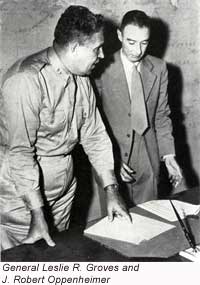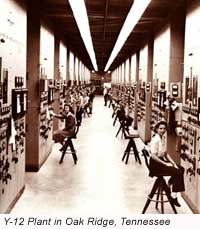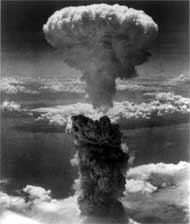The Manhattan Project, or more formally, the Manhattan Engineering District, was an effort during World War II to develop the first nuclear weapons by the United States with assistance from the United Kingdom and Canada. Its research was directed by American physicist J. Robert Oppenheimer, and overall by General Leslie R. Groves after it became clear that a weapon based on nuclear fission was possible and that Nazi Germany was also investigating such weapons of its own.
  Though it involved over thirty different research and production sites, the Manhattan Project was largely carried out in three secret scientific cities that were established by power of eminent domain: Hanford, Washington, Los Alamos, New Mexico, and Oak Ridge, Tennessee. Some families in Tennessee were given two weeks notice to vacate the family farm lands they had possessed for generations. The Los Alamos National Laboratory was built on a mesa that previously hosted the Los Alamos Ranch School, a private residential boys school that featured the outdoors and horses (famous alumni included William Burroughs). The Hanford Site, which grew to almost 1000 square miles (2,600 km²), incorporated land from some farms and two small towns, Hanford and White Bluffs. The Oak Ridge facilities cover more than 60,000 acres (243 km²) of several former farm communities. The existence of these cities was officially kept secret until the end of the war. Though it involved over thirty different research and production sites, the Manhattan Project was largely carried out in three secret scientific cities that were established by power of eminent domain: Hanford, Washington, Los Alamos, New Mexico, and Oak Ridge, Tennessee. Some families in Tennessee were given two weeks notice to vacate the family farm lands they had possessed for generations. The Los Alamos National Laboratory was built on a mesa that previously hosted the Los Alamos Ranch School, a private residential boys school that featured the outdoors and horses (famous alumni included William Burroughs). The Hanford Site, which grew to almost 1000 square miles (2,600 km²), incorporated land from some farms and two small towns, Hanford and White Bluffs. The Oak Ridge facilities cover more than 60,000 acres (243 km²) of several former farm communities. The existence of these cities was officially kept secret until the end of the war.
  The Project culminated in the design, production, and detonation of three nuclear weapons in 1945. The first was on July 16: "Trinity", the world's first nuclear test, near Alamogordo, New Mexico. The second was the weapon "Little Boy", detonated on August 6, over the city of Hiroshima, Japan. The third was the weapon "Fat Man", detonated on August 9, over the city of Nagasaki, Japan. The Project culminated in the design, production, and detonation of three nuclear weapons in 1945. The first was on July 16: "Trinity", the world's first nuclear test, near Alamogordo, New Mexico. The second was the weapon "Little Boy", detonated on August 6, over the city of Hiroshima, Japan. The third was the weapon "Fat Man", detonated on August 9, over the city of Nagasaki, Japan.
The primary sites of the project exist today as Hanford Site, Los Alamos National Laboratory, Oak Ridge National Laboratory, the National Security Complex and several other plants.
By 1945, the Project employed over 130,000 people at its peak and cost a total of nearly $2 billion USD ($20 billion in 2004 dollars based on CPI.
The industrial problem centered on the production of sufficient fissile material, of sufficient purity. Two separate, completely parallel efforts were undertaken to do this, and the results are represented in the single test and the two bombs which were dropped.
 The Hiroshima bomb, Little Boy, was based on uranium-235, a rare isotope of uranium that has to be physically separated from more prevalent uranium-238 isotope, which is not suitable for use in an explosive device. The separation was effected mostly by gaseous diffusion of uranium hexafluoride (UF6), but also by other techniques, such as thermal diffusion, and the calutron method, using the mass spectrometer principle of magnetic separation. The bulk of this separation work was done at Oak Ridge. The bomb itself used the so-called "gun" mechanism to assemble a critical mass of the fissile U-235; one mass of U-235 was fired down a tube into another mass. The Hiroshima bomb, Little Boy, was based on uranium-235, a rare isotope of uranium that has to be physically separated from more prevalent uranium-238 isotope, which is not suitable for use in an explosive device. The separation was effected mostly by gaseous diffusion of uranium hexafluoride (UF6), but also by other techniques, such as thermal diffusion, and the calutron method, using the mass spectrometer principle of magnetic separation. The bulk of this separation work was done at Oak Ridge. The bomb itself used the so-called "gun" mechanism to assemble a critical mass of the fissile U-235; one mass of U-235 was fired down a tube into another mass.
In contrast, the devices used in the first and only test, and also the Nagasaki bomb, Fat Man, consisted primarily of plutonium-239. This is a synthetic element which, in the form created by the reactors used to produce it, contains too much of an isotope which too readily undergoes fission for it to be used in gun type device. (The issue is that due to the relatively slow assembly speed of the gun type device, the bomb will "fizzle"; i.e. blow itself apart before it develops maximum power.) A so-called "implosion" device, in which a sphere of fissile material was collapsed on itself, promised faster assembly, and thus offered a solution to the problem. The design of an implosion device was at the center of the efforts by physicists at Los Alamos during the Project.
The property of uranium-238 which makes it less suitable directly for use in an atomic bomb is used in the production of plutonium -- with sufficiently slow neutrons, uranium-238 will absorb neutrons and transmute into plutonium-239. The production and purification of plutonium was at the center of wartime, and post-war, efforts at the Hanford Site, using techniques developed in part by Glenn Seaborg.
The first live test of the plutonium bomb was on July 16, 1945, near Alamagordo, New Mexico, and was code-named "Trinity". "The energy developed in the test was several times greater than that expected by scientific group."
|